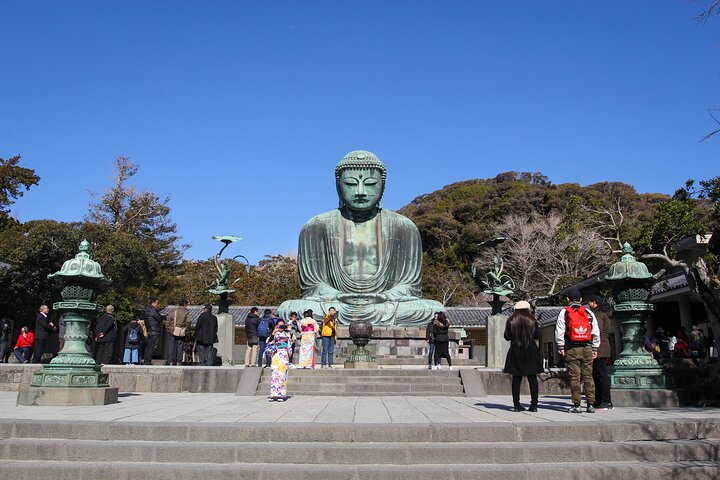Private Kamakura plus Yokohama Tour - English Speaking Driver
Share this tour

Offered languages
- Japanese
- English
Kamakura is a seaside Japanese city just south of Tokyo. The political center of medieval Japan, modern-day. Kamakura is a prominent resort town with dozens of Buddhist Zen temples and Shinto shrines. Most recognizable landmark is the Kotoku-in Temple’s Great Buddha, a roughly 13m-high bronze statue still standing after a 15th-century tsunami.
Yokohama city contains a large Chinatown with hundreds of Chinese restaurants and shops. Also known for Sankei-en Garden, a botanical park containing preserved Japanese residences from different eras, and the seaside Minato Mirai district, site of the 296m Landmark Tower.
Tour duration is approx 10 hours including commuting time. A group of more than 5 people can be facilitated at an additional cost.
- Bilingual Chauffeur
- See all top sights in one day
- Provide assistance to take your photos if needed
- Hassle-free tour
- Get local tips and insights
- Make the most of limited time with convenient pickup and drop-off
What's Included
Meeting and pickup
We pick you up at your Hotel, Residence, Restaurant or any other location within Tokyo and drop off at the same point. If you need to be picked up at a different location or require a different drop off point, please let us know. If your pickup location is not in the list then you can type the location's information. Furthermore, we are flexible to provide pickup / drop off service outside of Tokyo at an additional cost.
Itinerary
-
1Hokoku-ji Temple
Hōkoku-ji is an old temple in the Kenchō-ji school of the Rinzai sect of Zen Buddhism located in Kamakura, Japan. Famous for its bamboo garden, it is also known as "Bamboo Temple". A statue of Gautama Buddha, called Shaka Nyorai in Japanese, in a sacred hall is the temple's principal image.
1 hour • Admission ticket not included -
2Hasedera Temple
Hase-dera, commonly called the Hase-kannon is one of the Buddhist temples in the city of Kamakura in Kanagawa Prefecture, Japan, famous for housing a massive wooden statue of Kannon. The temple originally belonged to the Tendai sect of Buddhism, but eventually became an independent temple of the Jōdo-shū.
45 minutes • Admission ticket not included -
3Kotoku-in (Great Buddha of Kamakura)
Kōtoku-in is a Buddhist temple of the Jōdo-shū sect, in the city of Kamakura in Kanagawa Prefecture, Japan. Its mountain name is Taiizan, and its common temple name is Shōjōsen-ji.
30 minutes • Admission ticket not included -
4Tsurugaoka Hachimangu Shrine
The shrine is a cultural center of the city of Kamakura and serves as the venue of many of its most important festivals with two museums. Two beautiful ponds represent the Taira and Minamoto clans.
1 hour • Admission ticket not included -
5Kamakura Komachidori
Busy pedestrian walkway lined with apparel, gift & souvenir stores, plus eateries & sweet shops.
1 hour 30 minutes • Admission ticket free -
6Yokohama Chinatown
It is about 160 years old, with a population of about 3,000 to 4,000. Today, only a few Chinese people still live there, most being from Guangzhou.
1 hour • Admission ticket free -
7Sankeien Gardens
Sankei-en is a traditional Japanese-style garden in Naka Ward, Yokohama, Japan, which opened in 1906. Sankei-en was designed and built by Tomitaro Hara, known by the pseudonym Sankei Hara, who was a silk trader.
1 hour • Admission ticket not included -
8Minatomirai
We will visit this place if time permits. Minatomirai is a futuristic waterfront with a high-rise observation deck and stylish boutiques at Yokohama Landmark Tower and Plaza. Families also take in the skyline from the Cosmo Clock 21 Ferris wheel or tour the 1930s sailing ship Nippon Maru. Mitsubishi Industrial Museum has dynamic exhibits of rockets and submarines, while Rinko Park hosts summer concerts. Waterside promenades host upscale bars and eateries.
30 minutes • Admission ticket free
Additional info
- Wheelchair accessible
- Infants and small children can ride in a pram or stroller
- Public transportation options are available nearby
- Specialized infant seats are available
- All areas and surfaces are wheelchair accessible
- Suitable for all physical fitness levels
Show 3 more
Additional info
- Wheelchair accessible
- Infants and small children can ride in a pram or stroller
- Public transportation options are available nearby
- Specialized infant seats are available
- All areas and surfaces are wheelchair accessible
- Suitable for all physical fitness levels
- Tour duration is approx 10 hours including commuting time.
- A group of more than 5 people can be facilitated at an additional cost.
- This is not a guided tour but can be arranged on request at an additional cost of a guide.
Tags
Cancellation Policy
For a full refund, cancel at least 24 hours before the scheduled departure time.
Show more
Cancellation Policy
- For a full refund, you must cancel at least 24 hours before the experience’s start time.
- If you cancel less than 24 hours before the experience’s start time, the amount you paid will not be refunded.
- Any changes made less than 24 hours before the experience’s start time will not be accepted.
- This experience requires good weather. If it’s canceled due to poor weather, you’ll be offered a different date or a full refund.
Rating
You can cancel up to 24 hours in advance of the experience for a full refund.
Your guide to the flawless travel experience












